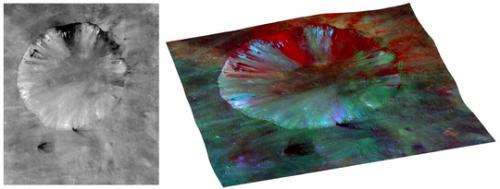Presence of serpentine on Vesta suggests exogenic origin

(Phys.org) —Rocks are silent storytellers: because each mineral is created only under certain conditions, they provide insight into the evolution of the body on which they are found. Scientists from the Max Planck Institute for Solar System Research (MPS) in Germany have now begun to tell such a story from the enigmatic dark material discovered on the protoplanet Vesta. Using data from the framing camera aboard NASA's Dawn spacecraft, the researchers have succeeded for the first time in identifying a mineral component of this material: serpentine. The new discovery puts an end to the discussion about the origin of the dark material: impacts of primitive asteroids must have distributed it on Vesta.
The so-called dark material that can be found scattered over the surface of the protoplanet Vesta is one of its most unusual features. Ever since Dawn's arrival in July 2011, this material, that absorbs light as efficiently as soot, has sparked discussions within the scientific community. What is it made of? How did it originate? And what does it tell us about this unique body that took the first steps towards becoming a planet, but got stuck in an early evolutionary phase approximately 4.5 billion years ago?
In their new study, the MPS researchers answer some of these questions. Almost a year ago, researchers had characterized the dark material to be rich in carbon. Now they are able to identify the silicate serpentine as one of the components of the dark material. "Identifying complex minerals instead of just individual elements and simple compounds such as OH-groups, helps us substantially", Dr. Andreas Nathues from the MPS explains.
Like any mineral, serpentine is formed only under certain conditions: pressure and temperature must be neither too high nor too low; if other elements such as hydrogen are present, different minerals are formed. "The detection of minerals as components of the dark material gives us access to a completely new type of information," says Nathues. "We are no longer restricted to answering the question, what the dark material is made of. The minerals tell us what conditions it was exposed to."
Serpentine, for example, cannot survive temperatures above 400 degrees Celsius. "The dark material can therefore not have been exposed to great heat", concludes Dr. Martin Hoffmann from the MPS. Because Vesta - unlike the much smaller asteroids - was once hot and melted, the the dark material cannot have originally belonged to the protoplanet. A volcanic origin, which some scientists had suspected, can also be ruled out.
"The only reasonable explanation is the impacts of asteroids," says Hoffmann, who points out that some primitive meteorites contain serpentine. These meteorites are regarded as fragments of carbon-rich asteroids. The impacts must have been comparatively slow, because an asteroid crashing at high speeds would have produced temperatures too high to sustain serpentine. In a previous study, scientists from the MPS had calculated how dark material would be distributed on Vesta as a result of a low-speed oblique impact. Their results are consistent with the distribution of dark material on the edge of one of the two large impact basins in the southern hemisphere.
Key to the current results was a new and more accurate analysis of the images Dawn acquired while orbiting Vesta from July 2011 to September 2012. The camera system's seven color filters can distinguish certain wavelength ranges from Vesta's reflected light and thus detect the characteristic fingerprints of certain materials. "The areas where the dark material are found on the slopes of steep craters are not large. Sometimes they extend only a few hundred meters", Nathues, framing camera Lead Investigator explains, highlighting the special challenges of these measurements. Only by carefully recalibrating the instrument was it possible to elicit this new information from the data. In addition, the researchers used data from Dawn's visible and infrared mapping spectrometer.
To confirm their identification of serpentine, the researchers also examined mineral mixtures and meteorites containing serpentine in the laboratory. The fingerprints from these samples are in good agreement with the data from Vesta.
More information: Andreas Nathues, Martin Hoffman et al.: "Detection of Serpentine in Exogenic Carbonaceous Chondrite Material on Vesta from Dawn FC Data," Icarus, in press, DOI: 10.1016/j.icarus.2014.06.003
Journal information: Icarus
Provided by Max Planck Society





















